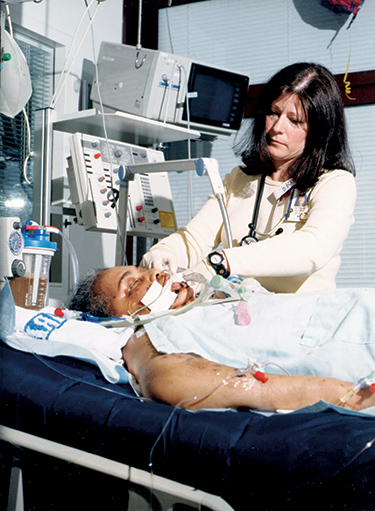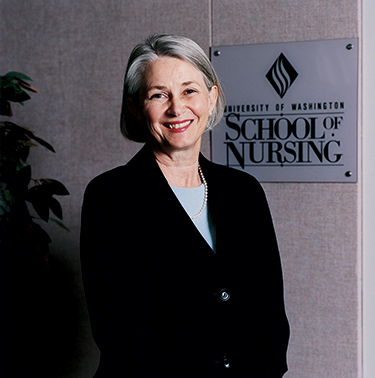Five years ago, Harborview Medical Center wouldn’t even think of hiring nurses straight out of school. Internationally recognized for its work as King County’s Level I trauma center, as well as the Pacific Northwest’s primary hospital for treating burns, HIV/AIDS and diseases in the neurosciences, Harborview would only go for the most experienced, highly skilled nurses available.
Today, things have changed. The Seattle hospital currently has 90 rookie nurses on staff—10 percent of its entire nursing department. And in another move considered unnecessary five years ago, Harborview also covers loans for nursing students in exchange for having those students pay off their debts by working at the hospital.
The nursing shortage plaguing America—as of December, 126,000 nursing positions remained unfilled, according to the American Hospital Association—has forced hospitals and health-care organizations to drastically change their thinking as they cope with a crisis whose roots run so deep, many wonder if it will ever be solved.
“In the past few years,” says Johnese Spizzo, Harborview’s chief operating officer and former chief nursing officer, “the nursing shortage has just gotten worse. We don’t know if there are enough people in the pipeline coming into the profession. So we had to change with the times.”

UW Medical Center Nurse Victoria Hutman, ’99, examines a patient. Photo by Gavin Sisk.
Grappling with the effects of the nursing shortage has become one of the new focuses of the University of Washington School of Nursing. Long ranked the top nursing school in the nation for its research in such areas as aging, women’s health, addiction, and the brain and public health, the school is now taking innovative steps to do what it can to reverse the disappearing act of nurses and nursing faculty.
Historically speaking, nursing shortages are really nothing new; there have been many ups and downs before. “But this one is different,” declares Sue Woods, associate dean for academic programs at the school. “The population is aging, diseases are more acute, we have aging workers, and people are not choosing nursing as a career.”
While the latter is definitely true, many top nursing programs, such as the UW’s, have been turning away droves of potential students because of the lack of enrollment funding. And without more support for higher education—which won’t happen any time soon, given the state’s staggering budget deficit—nursing schools will have no choice but to continue shutting the door on prospective students.
Take the UW’s acclaimed Bachelor of Science in Nursing program. Last year, the school received 305 applications for its 80 slots. (It expects more than 400 this year.) What hurts is that 90 percent of those candidates were qualified for admission. One current UW nursing student, Matt McNulty, applied three times before he was accepted. And that was despite the fact that he had a chemistry degree, as well as experience as an emergency medical technician, medical assistant and biology teacher.
“It kills us to turn away qualified students in light of the shortage,” laments Carolyn Chow, the nursing school’s recruiting and admissions coordinator.
The lack of nursing students translates into real problems in clinical settings. Matt Knight, a 29-year-old certified nursing assistant at Harborview, says he can work as much overtime as he wants. “There are always overtime shifts available,” he says. Stephen Hopkins, a nurse at Harborview, knows that situation all too well. “Some nights we have enough people and it’s great,” he says. “Other nights, it’s tough. You’re running, and you don’t get a lot of down time.”
At the same time nursing schools can’t raise their enrollments, complaints about stressful working conditions, too much overtime and low pay have spurred many nurses to leave the profession altogether. (According to Nursing Professor David Keepnews, nearly 20 percent of licensed registered nurses are not practicing.) “Seeing nurses as angels of mercy has got to go,” retired Nursing Professor Jim Bush flatly states. “That’s nice, but you can’t raise a family on that.”
Lack of funding is what has put nursing schools like the UW in a bind. The UW simply doesn’t have the money to hire enough clinical faculty, who provide essential hands-on training for students outside of the classroom. At the school’s Seattle campus, for example, the size of the faculty has decreased by 25 percent since 1978, while there has been no such decline in the number of students.
“You don’t want to pump through students who aren’t prepared. You can’t just focus on numbers of people. Quality is still the main issue.”
Jim Bush, retired nursing professor
“We had to become entrepreneurial,” explains Nursing Dean Nancy Fugate Woods. “We just don’t have the resources we need.” And with each faculty member only able to accommodate a maximum of eight students because of the hands-on nature of the job, that can add up to a lot of money.
So UW nursing officials asked area hospitals to shift some their recruitment budget away from newspaper ads and career fairs to pay the salary of a clinical instructor. This instructor would come from their nursing staff and work at the UW. Nursing students would work with that instructor for a year, then spend a designated amount of time working at the hospital.
Hospitals loved the idea because it was a way they could reward their best nurses with a sabbatical from the rigors of daily patient care. It also gave the hospitals a pipeline to prospective employees. And for the UW, it was a way to sustain enrollment without having to spend money it didn’t have to hire additional faculty members.
“We have been trying to meet the increasing needs of the nursing labor force at a time when money for higher education is shrinking,” adds Dean Woods. “We have been forced to do more with less, and this is one creative way to have more faculty without paying for it.”
But finding clinical instructors isn’t that easy. Teaching doesn’t pay very well, benefits are not always provided, and the responsibilities are immense. And while hospitals want to get more nurses into the workplace, having nursing students on the floor increases the workloads of other nurses. And so it goes.

UW Nursing School Dean Nancy Fugate Woods says the nursing shortage will never be solved unless nursing schools get more funding to accommodate more students. Photo by Mary Levin.
Another strategy has been having local hospitals offer loans to UW nursing students. In exchange, each student receiving such funding would repay the loan by working at the hospital. The idea, hatched by the Veteran’s Affairs Department, allowed nine UW bachelor of nursing students to get full tuition support and a stipend in exchange for their agreement to work in a veteran’s hospital for two years after graduation. UW Medical Center, Harborview and Virginia Mason Medical Center began similar programs during the past two years. And there is a good chance other Seattle-area hospitals, such as Northwest and Evergreen, might join as well.
Another idea for getting students in the door is an accelerated baccalaureate program. Under this idea, about 20 students in a class of 80 would complete their schooling in five consecutive quarters instead of the usual six quarters with summers off.
But simply pushing more students through nursing programs isn’t the only answer, according to Bush, the retired nursing professor. “You need seasoned, mature faculty teaching,” he explains. “You don’t want to pump through students who aren’t prepared. You can’t just focus on numbers of people. Quality is still the main issue.” And quality can be threatened. Bush recalls the time he recently went to have his blood pressure checked and the nurse tending him didn’t use the correct sized cuff, creating an inaccurate reading.
“The shortage has affected education because practicing nurses have less and less time for students,” says Pam Mitchell, associate dean for research in the school. “Students work a lot with staff nurses, but as the work environment becomes more intense, there is less time for actual teaching. Hospitals simply can’t afford for their nurses to spend their time teaching. The hours are long, the pressure is great.”
While the bulk of the publicity on the nursing shortage centers around patient care—a recent study by the Joint Commission on Accreditation of Healthcare Organizations showed that the growing shortage of nurses is putting patient lives in danger—a quiet crisis that has quickly taken hold is finding teachers, especially for nursing school faculty. At the UW, the average age of the nursing faculty is 56, and many are going to be retiring in the next few years. This problem is nationwide. In Georgia, for example, a quarter of that state’s nursing school faculty will retire or leave the profession in the next four years. (And that is not to mention the clinical side, where 40 percent of working registered nurses will be 50 years or older within the next decade.)
“In 5-10 years, there is going to be a tremendous faculty shortage. It is going to be very hard to replace the retiring faculty. We’re getting old.”
Sue Woods
The problem that keeps arising is money. “Nurses can make far better money in advanced patient care than as a starting faculty member,” says Mitchell. A starting faculty member with a Ph.D at the UW School of Nursing makes $54,764. Overall, since 1990, Dean Woods points out, nursing faculty salaries have been flat, while many health-care organizations have used signing bonuses and flexible schedules to attract nurses.
“In 5-10 years, there is going to be a tremendous faculty shortage,” Sue Woods says. “It is going to be very hard to replace the retiring faculty. We’re getting old.”
The UW has the state’s only nursing doctoral program (UW Bothell and UW Tacoma offer baccalaureate and master’s degrees) and unlike community colleges, where nursing teachers only need master’s degrees, the UW and other universities of its stature require Ph.D.s for its faculty.
Diversity has always been a problem for nursing too, which historically has been a place for white women. Breaking down stereotypes and attracting people of color and men is an ongoing goal of the school’s outreach program, which reaches as low as middle school to entice kids to consider nursing as a career.
Though the future looks bleak—surveys show that by 2010, there will be 400,000 fewer nurses than needed for patient care—Nursing Dean Woods isn’t fazed. “I am an unqualified optimist,” she says. “I believe we will be able to convey to students what incredible opportunities there are in nursing. And how you can make a real difference in a person’s life. I loved being a nurse in clinical practice and caring for patients. What I find so rewarding is to pass that along to our next generation of nurses. We just need to work hard to find them and to fund them.”